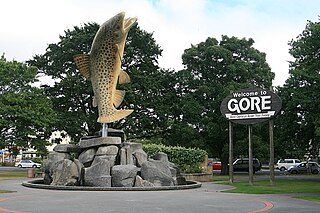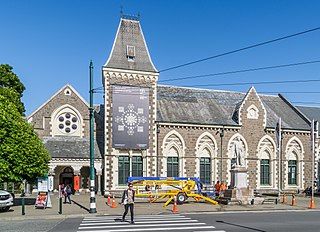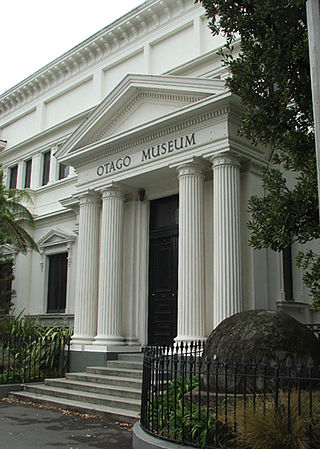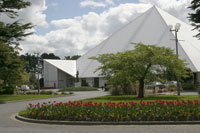
Gore is a town and district in the Southland region of the South Island of New Zealand. It has a resident population of 8,240 as of June 2023. Gore is known for its country music scene and hosts an annual country music festival. The town is also surrounded by farmland and is an important centre for agriculture in the region.

Invercargill is the southernmost and westernmost city in New Zealand, and one of the southernmost cities in the world. It is the commercial centre of the Southland region. The city lies in the heart of the wide expanse of the Southland Plains to the east of the Ōreti or New River some 18 km north of Bluff, which is the southernmost town in the South Island. It sits amid rich farmland that is bordered by large areas of conservation land and marine reserves, including Fiordland National Park covering the south-west corner of the South Island and the Catlins coastal region.

Riverton, officially Riverton / Aparima, is a small New Zealand town 30 kilometres (19 mi) west of Invercargill, on the south-eastern shorelines of the Jacobs River Estuary. The estuary is formed by the Aparima and Pourakino rivers, leading through a narrow outflow channel into Foveaux Strait. Accessible via State Highway 99 on the Southern Scenic Route, the main part of the town is on flat land and the northern end of Oreti Beach. South Riverton is built on the hills between the eastern shore of the estuary and Taramea Bay.

Anna Jacoba Westra, known as Ans Westra, was a Dutch-born New Zealand photographer, well known for her depictions of Māori life in the 20th century. Her prominence as an artist was amplified by her controversial 1964 children's book Washday at the Pa.

The Museum of New Zealand Te Papa Tongarewa is New Zealand's national museum and is located in Wellington. Usually known as Te Papa, it opened in 1998 after the merging of the National Museum of New Zealand and the National Art Gallery. An average of more than 1.5 million people visit every year, making it the 26th-most-visited art gallery in the world. Te Papa operates under a bicultural philosophy, and emphasises the living stories behind its cultural treasures.

The Canterbury Museum is a museum located in the central city of Christchurch, New Zealand, in the city's Cultural Precinct. The museum was established in 1867 with Julius von Haast – whose collection formed its core – as its first director. The building is registered as a "Historic Place – Category I" by Heritage New Zealand.
Graham Percy was a New Zealand-born artist, designer and illustrator. His work was the subject of The Imaginative Life and Times of Graham Percy, a major posthumous exhibition of his work which was shown at galleries throughout New Zealand including City Gallery Wellington, Gus Fisher Gallery Auckland, Sarjeant Gallery Whanganui, the Rotorua Museum and the Southland Museum and Art Gallery, Invercargill.

Auckland Art Gallery Toi o Tāmaki is the principal public gallery in Auckland, New Zealand. It has the most extensive collection of national and international art in New Zealand and frequently hosts travelling international exhibitions.

Tūhura Otago Museum is located near the city centre of Dunedin, New Zealand, adjacent to the University of Otago campus. The museum has one of the largest collections in New Zealand, and is one of the city's leading attractions. Natural science specimens and humanities artefacts from the Otago region and around the world form the basis for long-term gallery displays. An interactive science centre within the museum includes a large, immersive tropical rainforest butterfly house.

Anderson Park is a park in Invercargill, New Zealand. It consists of a Georgian-style residence set in 24 hectares of landscaped gardens. The house displays Invercargill's extensive collection of New Zealand art.

The Christchurch Art Gallery Te Puna o Waiwhetū, commonly known as the Christchurch Art Gallery, is the public art gallery of the city of Christchurch, New Zealand. It has its own substantial art collection and also presents a programme of New Zealand and international exhibitions. It is funded by Christchurch City Council. The gallery opened on 10 May 2003, replacing the city's previous public art gallery, the Robert McDougall Art Gallery, which had opened in 1932.

Southland is New Zealand's southernmost region. It consists of the southwestern portion of the South Island and includes Stewart Island. Southland is bordered by the culturally similar Otago Region to the north and east, and the West Coast Region in the extreme northwest. The region covers over 3.1 million hectares and spans 3,613 km of coastline. As of June 2023, Southland has a population of 103,900, making it the eleventh-most-populous New Zealand region, and the second-most sparsely populated. Approximately half of the region's population lives in Invercargill, Southland's only city.

MTG Hawke's Bay Tai Ahuriri is a museum, theatre and art gallery in Napier in New Zealand. MTG Hawke's Bay occupies three buildings that were redeveloped in 2013.
Te Moemoea no Iotefa was the first exhibition held in a civic art gallery in New Zealand focused on contemporary Pacific art.
Marilynn Lois Webb was a New Zealand artist, noted for her contributions to Māori art and her work as an educator. She was best known for her work in printmaking and pastels, and her works are held in art collections in New Zealand, the United States, and Norway. She lectured at the Dunedin School of Art, and was made an emeritus principal lecturer in 2004.
Adrienne Martyn is a New Zealand art photographer. Her work has been collected by numerous art galleries, museums and libraries in New Zealand including the Museum of New Zealand Te Papa Tongarewa, the Dowse Art Museum, the Auckland Art Gallery, the Christchurch Art Gallery and the Hocken Library.
Heather Straka is a New Zealand artist, based in Auckland, who primarily works with the media of painting and photography. Straka is well known as a painter that utilises a lot of detail. She often depicts cultures that are not her own, which has caused controversy at times. Her work engages with themes of economic and social upheaval in interwar China, the role of women in Arabic society and Māori in relation to colonisation in New Zealand. Eventually, the figure became important in Straka's practice and she began to use photographs as the starting point for some of her works and "Increasingly too the body feminine has become her milieu".
Invercargill Central is a shopping centre located in the central business district of Invercargill, New Zealand. Stage one of the project opened on 14 July 2022.
Monica Frances Barham was a New Zealand architect.

















